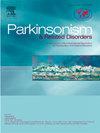基于机器学习的帕金森病社区居民诊断模型的开发与验证:来自中国健康与退休纵向研究(CHARLS)的证据。
IF 3.1
3区 医学
Q2 CLINICAL NEUROLOGY
引用次数: 0
摘要
背景:帕金森病(Parkinson's disease,PD)是中老年人主要的神经退行性疾病:帕金森病(Parkinson's disease,PD)是中老年人主要的神经退行性疾病:本研究旨在利用中国健康与退休纵向研究(CHARLS)的数据,开发并验证基于机器学习的诊断模型,以识别社区居民中的PD患者:我们利用了CHARLS数据集中19134名45岁及以上人群的数据,其中有265名成年人被报告患有帕金森病。外部验证队列包括1500人,其中21人(1.4%)患有帕金森病。我们使用随机森林(RF)算法建立了一个可解释的帕金森病预测模型,该模型通过10倍交叉验证进行了内部验证,并通过苏北人民医院的数据集进行了外部验证。采用SHAPLE Additive exPlanation(SHAP)值来阐明模型的预测结果:RF模型表现稳健,曲线下面积(AUC)为0.884,灵敏度、特异性和F1得分都很高。该模型在外部验证队列中的表现突出,AUC 为 0.82,准确率为 0.99。该模型在内部和外部验证队列中的表现保持一致。SHAP分析深入揭示了各种预测因素的重要性和相互作用,提高了模型的可解释性:该研究提出了一种基于机器学习的诊断模型,该模型准确度高、可解释性强,可用于识别中国中老年人中的帕金森病患者。通过与预测性风险因素和慢性疾病信息相结合,该模型为早期识别和干预提供了有价值的见解,有可能缓解帕金森病的进展。本文章由计算机程序翻译,如有差异,请以英文原文为准。
Development and validation of a machine learning-based diagnostic model for Parkinson's disease in community-dwelling populations: Evidence from the China health and retirement longitudinal study (CHARLS)
Background
Parkinson's disease (PD) is a major neurodegenerative disorder in Middle-aged and elderly people.There is a pressing need for effective predictive models, particularly in chinese population. Objective:This study aims to develop and validate a machine learning-based diagnostic model to identify individuals with PD in community-dwelling populations using data from the China Health and Retirement Longitudinal Study (CHARLS).
Methods
We utilized data from 19,134 individuals aged 45 and above from the CHARLS dataset, with 265 adults reported to have PD. The external validation cohort included 1500 individuals, with 21 (1.4 %) having PD.The random forest (RF) algorithm was used to develop an interpretable PD prediction model, which was internally validated using 10-fold cross-validation and externally validated with a dataset from Northern Jiangsu People's Hospital. SHapley Additive exPlanation (SHAP) values were employed to elucidate the model's predictions.
Results
The RF model demonstrated robust performance with an Area Under the Curve (AUC) of 0.884 and high sensitivity, specificity, and F1 scores. The model's performance in external validation cohort, highlighting an AUC of 0.82 and an accuracy of 0.99. The model's performance remained consistent across internal and external validation cohorts. SHAP analysis provided insights into the importance and interaction of various predictors, enhancing model interpretability.
Conclusion
The study presents a highly accurate and interpretable machine learning-based diagnostic model to identify individuals with PD in middle-aged and older Chinese adults. By combined with predictive risk factors and chronic disease information, the model offers valuable insights for early identification and intervention, potentially mitigating PD progression.
求助全文
通过发布文献求助,成功后即可免费获取论文全文。
去求助
来源期刊

Parkinsonism & related disorders
医学-临床神经学
CiteScore
6.20
自引率
4.90%
发文量
292
审稿时长
39 days
期刊介绍:
Parkinsonism & Related Disorders publishes the results of basic and clinical research contributing to the understanding, diagnosis and treatment of all neurodegenerative syndromes in which Parkinsonism, Essential Tremor or related movement disorders may be a feature. Regular features will include: Review Articles, Point of View articles, Full-length Articles, Short Communications, Case Reports and Letter to the Editor.
 求助内容:
求助内容: 应助结果提醒方式:
应助结果提醒方式:


